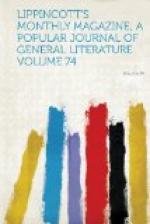The field most fruitful under its application is that of astronomy. Here, progress has been great. A measuring-rod has been provided for the depths of space by the ascertainment of the sun’s distance within a three-hundredth part of that body’s diameter. The existence of a cosmic ether, a resisting medium, has been established, and its retarding influence calculated. Many of the nebulae have been reduced, and others proved to be in a gaseous condition, like comets. The latter bodies have been chained down to regular orbits, followed far beyond those of the old planets, and brought into genealogical relations with these through the links of bolides and asteroids. The family circle of planets proper has been immensely increased, a new visitant to the central fire appearing every few years or even months. Newton connected the most distant points of the universe by the one principle of gravitation: the spectroscope unites them by identity of structure and composition. Improved instruments have detected the parallax of a number of the fixed stars, and traced motion in both solar and stellar systems as units. Coming homeward from the distant heavens, the advances of astronomy diminish as we near what may be called the old planets and our pale companion the moon. The existence of a lunar atmosphere and the habitability of Mars are still debated; with, we believe, the odds against both. But the star-gazers make their craft useful in a novel way when it reaches the earth. Upon the precession of the equinoxes they erect a fabric of retrograde chronology, and set a clock to geologic time. Here Sir Isaac is brought to grief. His excursions beyond the Deluge are proved blind guides. He misleads us among the ages as sadly as Archbishop Usher. The profoundest of laymen and the most learned of clerics are equally at sea in locating creation. That successive phases of animate existence were rising and fading with the oscillations of the earth’s inclination to its orbit never occurred to him to whom “all was light.” To probe the stars was to him a simpler process than to anatomize the globe upon which he stood.
This is the less remarkable when we reflect what a hard fight geology has had. A generation after Newton’s death fossils were referred for their origin to a certain “plastic power” in Nature—mere idle whittlings of bone that had never known an outfit of flesh and blood. Then came a long and motley procession of cosmogonies, every speculator, from John Wesley down to Pye Smith, insisting warmly on what seemed good in his own eyes. The last stand was made on the antiquity of man, and it is only a dozen years since the ablest of British—perhaps since Cuvier of modern—geologists, Sir Charles Lyell, yielded to the preponderance of evidence, and confessed that the era of man’s appearance on earth had been made too recent. A few determined skirmishers still linger behind the line of retreat, like Ney at the bridge of Kowno, and fire some fruitless shots at the advancing enemy. This is well. Tribulation and opposition are good for any creed, scientific or other. It weeds out the weak ones and strengthens those that are to stand.




